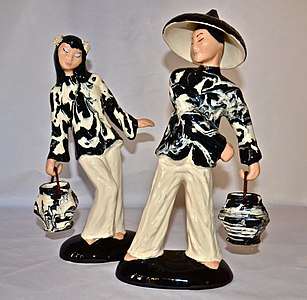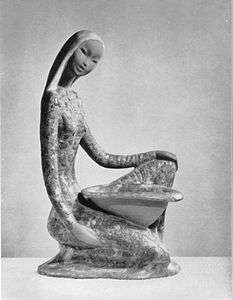Hedi Schoop
Hedi Schoop (3 April 1906 – 14 April 1995) was a Swiss-born German dancer, cabaret artist, sculptor and painter. From 1929 to 1933, she appeared in Berlin in the cabarets Die Katakombe and Tingel-Tangel-Theater. She emigrated with her first husband, Friedrich Hollaender, to California, where she turned to pottery. She founded a factory where ceramics based on her designs were produced from 1940 to 1958.
Hedi Schoop | |
|---|---|
 Hedi Schoop in 1957 | |
| Born | Hedwig Schoop 3 April 1906 Zürich, Switzerland |
| Died | 14 April 1995 (aged 89) Van Nuys, California, U.S. |
| Occupation |
|
| Spouse(s) |
|
Life
Hedwig "Hedi" Schoop was born in Zürich on 3 April 1906, the daughter of Friedrich Maximilian Schoop (1871–1924) and Emma Olga Schoop, née Böppli (1873–1959). Her grandfather Ulrich Schoop was a lecturer at the Kunstgewerbeschule in Zürich.[1] Her father was a journalist, including for the Zürcher Post, and president of the Grand Hotel Dolder. The family lived at the Zürichberg, where the hotel was also located.[2]
Schoop was the third of four children, the first being the painter Max Schoop, the second the dancer Trudi Schoop, and the youngest the composer Paul Schoop. The parents nurtured the artistic interests of their children.[3] Trudi and Hedi received drama instruction.[3][4] Schoop studied sculpture, architecture, painting and fashion design at the Kunstgewerbeschule Wien and the Reimann School in Berlin.[5][6] She probably learned dancing from her sister who opened a dance school in Zürich in 1924.[7]
When Werner Finck and Hans Deppe founded the cabaret Die Katakombe in Berlin on 16 October 1929, the ensemble also included the actor Theo Lingen, the dancers Trudi and Hedi Schoop, and the artist Erich Ohser.[8] Hedi Schoop appeared in parody pantomime, sometimes as a grotesque duo with her sister.[3]
When the cabaret dissolved in 1930,[9] Schoop turned to Friedrich Hollaender's Tingel-Tangel-Theater, which opened on 7 January 1931.[3] A guest of their first program was Marlene Dietrich, who had become famous singing Hollaender's songs, including "Ich bin von Kopf bis Fuß auf Liebe eingestellt". The December 1931 show Allez-Hopp![10] was reviewed by Alfred Polgar in Die Weltbühne, who wrote about her ability to present with a "trinity" of temperament, drollery and grace ("Dreieinigkeit von Temperament, Drolligkeit und Grazie"), lively physical humour ("lebhaftem körperlichem Witz") and biting parody ("saftig im Parodistischen").[11]
In 1932, Hollaender and Schoop married. Hollaender left the cabaret in January 1933, due to the Nazi regime, which closed it in 1935. The couple emigrated via Paris to the United States,[3] where Hollaender had a contract for three months with 20th Century Fox.[12] They lived in Hollywood and later in Hollywood Hills. They tried to run a cabaret in English, Tingel-Tangel-Theater, beginning on 3 May 1934 with a program Allez-Hopp! based on the former show. It was initially well attended,[13] but the attendance began to decline.[3] When Hollaender received a contract with RKO to produce a Western and compose the film score for it, he closed the cabaret.[14]
Hedi Schoop Art Creations
From 1935, Schoop turned to artistic work. She first modeled puppets and dressed them. When they were displayed by Barker Bros., she was advised to turn to more durable materials and began to produce ceramics. In 1940, she opened a production line,[15] Hedi Schoop Art Creations.[16] Schoop created ceramics for practical use, such as flower pots and candle holders. Figures were often rural people in national costumes, in simple design which carried coloring. She also created bowls and lamps, among other items, sometimes in series aimed at collectors.[3][16] Schoop hired people for the production but kept the designing for herself. In the late 1940s, the company had more than 50 employees and produced more than 30,000 pieces.[16] She employed other foreigners, including the journalist Ferdinand Kahn, the actor Ernő Verebes, the artist Sylvester Schäffer, the dancer Gitta Wallerstein, the actress Illa Rhoden and the cabaret artist Trude Berliner.[17][18][19]
 Oriental figurines
Oriental figurines Ruhe
Ruhe Katzenmutter
Katzenmutter
In 1943, Schoop married Ernő Verebes. They had a son, Tony (Anthony) Verebes, in 1946, who became a photographer.[20] The couple lived in Van Nuys. In 1974, Schoop illustrated a book by her sister Trudi, Won’t you join the dance?[21] Schoop died in Van Nuys[22] on 14[3] or 15 April 1995.[23]
References
- Oetterli 2009, p. 162.
- Seelig 1958, p. 100.
- Kühn 2007b.
- Kühn 2007a, p. 468.
- Hepcat.
- Kuhfuss-Wickenheiser 2009.
- Chaiklin 2005, p. 506.
- Greeve 2015, pp. 12–15.
- Greeve 2015, p. 13.
- Hollaender 1965, p. 260.
- Polgar 1932.
- Kühn 1996, p. 93.
- Hollaender 1965, pp. 328–329.
- Kühn 1996, pp. 97, 138.
- Anthony Verebes, 10 November 2015.
- Johnson 2012.
- Weniger 2011, p. 99.
- Kafka 1941.
- Kafka 1943.
- Anthony Verebes Photography, Homepage.
- Trudi Schoop, Peggy Mitchell: Won't You Join the Dance?: A Dancer's Essay Into the Treatment of Psychosis Mayfield Publishing Company, 1974, retrieved 27 April 2019
- "Social Security Death Index: Hedi S Verebes". FamilySearch. Alexandria, Virginia: Social Security Administration. April 1995. Retrieved 27 April 2019.
- "California Death Index: Hedi Schoop Verebes". FamilySearch. Sacramento, California: Department of Public Health Services. 15 April 1995. Retrieved 27 April 2019.
Cited sources
- Chaiklin, Sharon (2005). Garraty, John A. (ed.). Schoop, Trudi. American national biography, Supplement 2. New York. pp. 505–507.CS1 maint: ref=harv (link)
- Greeve, Swantje (2015). Werner Finck und die "Katakombe": ein Kabarettist im Visier der Gestapo (in German). Berlin.CS1 maint: ref=harv (link)
- Hollaender, Friedrich (1965). Von Kopf bis Fuß. Mein Leben mit Text und Musik (in German). Munich.CS1 maint: ref=harv (link)
- Johnson, Donald-Brian (2012). "Hedi vs. Kay: The Case Of The 'Copied' Ceramics. Design Trends In The Mid-20th Century". Antiques & Auction News.CS1 maint: ref=harv (link)
- Kafka, Hans (1941). "Hollywood Calling – Hans Kafka Speaking". Aufbau: 25.CS1 maint: ref=harv (link)
- Kafka, Hans (1943). "Hollywood Calling". Aufbau: 10.CS1 maint: ref=harv (link)
- "Hepcat Restorations, Hedi Schoop (ohne Nachweis) – Verzeichnis der Schülerinnen und Schüler der Schule Reimann". pp. 511–580.
- Kuhfuss-Wickenheiser, Swantje (2009). Die Reimann-Schule in Berlin und London 1902–1943: ein jüdisches Unternehmen zur Kunst- und Designausbildung internationaler Prägung bis zur Vernichtung durch das Hitlerregime (in German). Aachen. pp. 566–567.CS1 maint: ref=harv (link)
- Kühn, Volker (1996). Spötterdämmerung: vom langen Sterben des grossen kleinen Friedrich Hollaender (in German).CS1 maint: ref=harv (link)
- Kühn, Volker (2007a), "Schoop, Trudi", Neue Deutsche Biographie (NDB) (in German), 23, Berlin: Duncker & Humblot, pp. 468–469; (full text online)
- Kühn, Volker (2007b). "Schoop, Hedi". Deutsche Biography (in German). Retrieved 27 April 2019.CS1 maint: ref=harv (link)
- Oetterli, Bruno Oetterli (2009). Die zwei Leben der Trudi Schoop. Musik-, Tanz- und Kunsttherapie (in German). 20. pp. 162–164.CS1 maint: ref=harv (link)
- Polgar, Alfred (1932). "Allez hopp!". Die Weltbühne (in German): 76–77.CS1 maint: ref=harv (link)
- Seelig, Carl (1958). Originelle Gestalten der Familie Schoop. Thurgauer Jahrbuch (in German). pp. 95–110.CS1 maint: ref=harv (link)
- Weniger, Kay Weniger (2011). "Es wird im Leben dir mehr genommen als gegeben …". Lexikon der aus Deutschland und Österreich emigrierten Filmschaffenden 1933 bis 1945. Eine Gesamtübersicht. Hamburg: ACABUS Verlag. ISBN 978-3-86282-049-8.CS1 maint: ref=harv (link)
Further reading
Life and work
- Eric Bradley: Hedi Schoop In: Antique Trader Antiques & Collectibles Price Guide 2013. Cincinnati 2012, pp. 230–234, 4 pages with illustrations.
- Rudolf Vierhaus (ed.): Deutsche biographische Enzyklopädie. 9. Schlumberger – Thiersch. München 2008, p. 179.
External links
| Wikimedia Commons has media related to Hedi Schoop. |